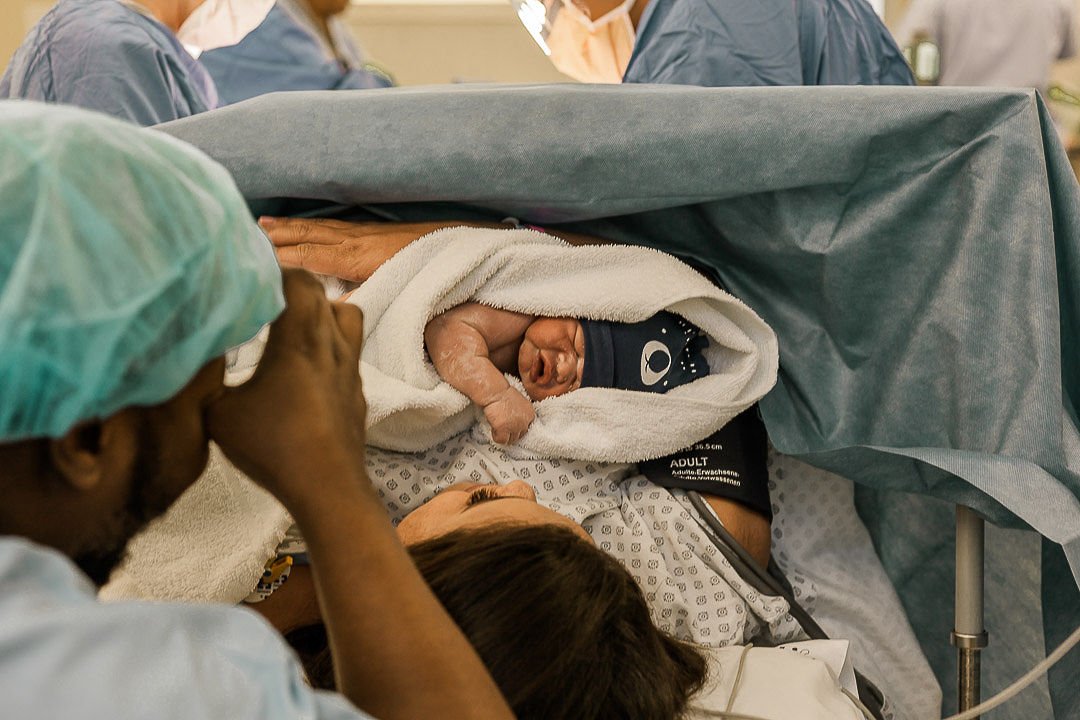Vaginal Seeding: What is it and how do you do it?
Vaginal Seeding: What is it and how do you do it?
If you are putting together your plans for a possible caesarean birth, you may have come across the concept of ‘vaginal seeding’. But what is it?
When a baby is born vaginally, they pass through the vagina and usually come out with their face towards your bottom/anus. On this journey, they pick up millions of tiny, invisible bacteria which go on to colonise their skin, mouth, respiratory system and gut, creating a living ecosystem of bacteria commonly referred to as their ‘microbiome’.
Whilst we are barely scratching the surface into microbiome research, we know that having a diverse microbiome has a positive impact on everything from allergies to asthma, eczema to digestive health, even behaviour and long term mental health!
We also know that babies born vaginally, out of sterile environments (such as birthing at home), receiving skin to skin and breastfeeding tend to have a more diverse microbiome than babies born by caesarean, in a sterile hospital environment, who don’t receive skin to skin or who receive antibiotics in labour/birth or the early postnatal period. It’s important to recognise that caesarean or hospital birth, or the use of antibiotics are absolutely not negative interventions when reached for appropriately. But, it certainly makes sense to explore ways in which an infant’s microbiome can be diversified if for any reason it ‘s development was disrupted (quite possibly due to very real medical need!). And this is where the concept of Vaginal Seeding comes in!
Vaginal Seeding involves placing a swab/gauze inside the vagina during the caesarean birth, allowing it to pick up some of the vaginal fluid and therefore bacteria; then taking this swab and rubbing on/in/around your baby’s mouth, nose, eyes, ears and hands.
The idea here would be that baby is exposed to new bacteria which then transfers to their digestive and respiratory systems; grows and diversifies the type of bacteria forming their microbiome.
There is currently limited evidence into the safety or benefit of the practise, but research is currently ongoing. For this reason, it isn’t something that appears in guidance and is usually something you as parents would have to raise, or even ‘do’ yourselves. Some physicians are reluctant to practise Vaginal Seeding as there is a chance that alongside transfering ‘good’ bacteria, you may inadvertently pass over bacteria which could be harmful to your baby (Such as a sexually transmitted disease, Herpes or Group B Strep- you may choose to test for these things ahead of your birth in you are planning a caesarean and are concerned). There is no evidence to say that this practise put baby at greater risk of harm however, particularly as they would have passed through these very same bacteria if they were born vaginally- both the benefits and risks are currently theorised rather than proven!
How do you do it?
If you have decided you would like to practise vaginal seeding- in a practical sense, this is what you would need to do:
Let your health care team know your intentions (either in a pre op appointment, antenatal appointment or if a plan changed to caesarean birth at any point in labour)
Ask for or provide sterile gauze/pad that can be used, moisten this with a saline solution for more comfortable insertation.
You may insert this yourself ahead of the birth in a planned caesarean (be sure your doctor is aware it is there for the safety of the surgery) or ask your doctor/midwife to insert it for you.
Remove the gauze/swab (or ask your midwife to) after the birth (leaving it in place for around 30-60 minutes)
Story in a sealed pot like the kind you may use for a urine sample until needed.
Rub the gauze/swab gentle over your baby’s face including their mouth, nose, eyes and ears, across their body and their hands (which they will put to their mouth frequently). It’s likely that you or your partner will need to do this yourselves, due to it being ‘out of guidelines’ in most UK hospitals.
Other ways you can develop a baby’s microbiome
Vaginal Seeding is one thing that may contribute to a more diverse microbiome, but it’s not all! Here are some other things that contribute positively.
Receiving Breastmilk- ideally directly from the breast for the greatest impact.
Skin to Skin, ideally right after birth, but if not then as soon as possible afterwards (with either parent). And continuing skin to skin throughout babyhood.
Avoiding unnecessary antibiotics (in both mum and baby).
Having a pet in the house!
Allowing your toddler/child to explore nature, dirt and mud!
Introducing a wide variety of solid food around 6 months
Delaying their first bath, certainly for at least 24 hours, but you can even wait a few weeks or longer.
Avoid antibacterial soaps (soap and water will do!)
Introducing probiotics may help
So, there you have it, an insight into vaginal seeding: the pros, the cons, the theories and the ‘how to’. I wonder if it’s something you would like to include in your birth plans or not?
Find out more about your options and choices for birth by joining us for a hypnobirthing and antenatal course, online or in person in Surrey, UK.
References:
Power CE, McShane BD, Gilligan PH et all; Microbiome and pediatric atopic dermatitis.
PubMed https://www.ncbi.nlm.nih.gov/pubmed/26388516
de Weerth C, Fuentes S, de Vos W; Crying in infants
On the possible role of intestinal microbiota in the development of colic. Taylor and Francis Online http://www.tandfonline.com/doi/abs/10.4161/gmic.26041
Mueller NT, Bakacs E, Combellick J et al; The infant microbiome development: mom matters. NCBI https://www.ncbi.nlm.nih.gov/pmc/articles/PMC4464665/
Prophylactic Probiotics for Preterm Infants: A Systematic Review and Meta-Analysis of Observational Studies https://pubmed.ncbi.nlm.nih.gov/26624488/
What is a healthy gut microbiome? http://thesociablescientist.com/baby-microbiome/
Dominguez-Bello M, Jesus-Laboy K, Shen N; Partial restoration of the microbiota of cesarean-born infants via vaginal microbial transfer. Nature Medicine http://www.nature.com/nm/journal/v22/n3/full/nm.4039.html

